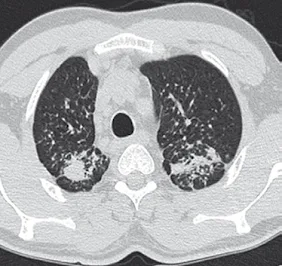Black Lung Disease (Coal Workers’ Pneumoconiosis)
Introduction to Black Lung Disease
Black Lung Disease, also known as Coal Workers’ Pneumoconiosis (CWP), is a chronic lung disease caused by prolonged inhalation of coal dust. This condition primarily affects coal miners and leads to a buildup of dust in the lungs, causing inflammation, scarring, and in severe cases, impaired lung function. The term "black lung" comes from the characteristic dark appearance of the lungs post-mortem due to coal dust deposits.
 |
| Chest X ray of a silicosis patient |
Causes
The primary cause of Black Lung Disease is long-term exposure to coal dust. However, several factors can increase a person's risk:
- Prolonged exposure to coal dust: The more dust inhaled over time, the higher the risk.
- Lack of protective gear: Absence or improper use of respiratory protection increases the chances of developing the disease.
- Poor ventilation: Inadequately ventilated mining environments can lead to higher concentrations of coal dust, exacerbating the risk.
Types and Stages of Black Lung Disease
Simple CWP:
In its early stages, the disease causes
small nodules to form in the lungs. Many individuals with simple CWP might not
show symptoms, but the disease can progress with continued exposure.
Complicated CWP or Progressive Massive Fibrosis (PMF):
This advanced stage is characterized by large masses of scar tissue (fibrosis)
in the lungs, severely limiting lung function and causing more pronounced
symptoms such as persistent coughing, breathlessness, and potential respiratory
failure.
Symptoms
The symptoms of Black Lung Disease vary based on the stage:
Early Symptoms: Persistent coughing and shortness of breath during physical exertion.
Advanced Symptoms:
Chronic cough, sometimes producing dark-colored sputum.
Constant shortness of breath, even when resting.
Chest pain, fatigue, and difficulty with daily tasks due to
respiratory limitations.
In severe cases, respiratory failure.
Diagnosis
Diagnosis involves multiple methods to assess the extent of lung damage:
- Chest X-rays: Used to detect nodules and signs of fibrosis in the lungs.
- Pulmonary function tests: These measure lung capacity and airflow to determine the degree of impairment.
- CT scans: Provide detailed imaging to assess the severity of lung scarring.
- Medical history: Doctors will evaluate the patient's history of coal dust exposure, smoking habits, and other occupational risks.
Treatment Options for Black Lung Disease
While there is no cure for Black Lung Disease, managing symptoms and preventing further damage is essential:
1. Medications for Black Lung Disease:
Bronchodilators: These medications help relax the muscles around the airways, allowing them to open up and making it easier for patients to breathe. This is especially helpful for reducing symptoms like shortness of breath and chest tightness, which are common in Black Lung Disease. Examples of commonly used bronchodilators include:
- Albuterol (Proventil, Ventolin): A fast-acting bronchodilator often used in inhalers for quick relief of breathing difficulties.
- Salmeterol (Serevent): A long-acting bronchodilator that helps maintain open airways for extended periods, used regularly to control symptoms.
- Tiotropium (Spiriva): Another long-acting bronchodilator that helps keep the airways open and reduces breathing difficulties over the long term.
These medications are typically delivered via inhalers or nebulizers to target the lungs directly and provide fast symptom relief.
2. Oxygen therapy:
As lung function deteriorates, some patients may need supplemental oxygen to maintain adequate blood oxygen levels. This helps relieve symptoms of breathlessness and fatigue.
3. Pulmonary rehabilitation:
This program includes exercises, breathing techniques, and education to help patients manage their symptoms and improve their lung capacity.
4. Avoidance of further exposure:
The most critical step is stopping further exposure to coal dust, which can prevent the disease from worsening. Retiring from mining work and using respiratory protection in similar environments is essential.
Complications
- Chronic Obstructive Pulmonary Disease (COPD): Many individuals with Black Lung Disease develop COPD, a condition that further limits airflow and lung function.
- Heart problems: Increased pressure in the lungs due to Black Lung Disease can cause pulmonary hypertension, leading to heart strain and potential heart failure.
- Increased mortality: Advanced stages of the disease can lead to respiratory failure, significantly reducing life expectancy.
Prevention
The best way to prevent Black Lung Disease is by reducing exposure to coal dust:
Dust control in mines: Implementing and enforcing regulations on coal dust levels is critical in preventing Black Lung Disease. Dust suppression techniques should be employed wherever possible.
Proper protective gear: Miners should use respiratory protection consistently to reduce the amount of dust inhaled.
Health surveillance: Regular medical check-ups, including lung function tests, can detect early signs of Black Lung Disease, allowing for early intervention.
Legal and Social Aspects
Many countries offer compensation for miners affected by Black Lung Disease. In the U.S., for example:
The Black Lung Benefits Act provides financial assistance and medical coverage to workers diagnosed with pneumoconiosis.
Organizations like the United Mine Workers of America (UMWA) and the Black Lung Association advocate for miners' rights and provide support to those affected by the disease.
Prognosis
The prognosis for individuals with Black Lung Disease varies depending on the stage at which the disease is diagnosed and whether further exposure to coal dust is stopped. Early intervention and consistent management can improve quality of life, though the disease is progressive, and advanced stages can lead to significant respiratory and heart issues, ultimately reducing life expectancy.
Conclusion
Black Lung Disease remains a serious occupational health issue, particularly in the coal mining industry. While treatment can help manage symptoms and slow the progression of the disease, prevention through dust control and proper protective measures is key. Ongoing advocacy for stronger health and safety regulations, along with legal support for affected workers, is essential in tackling this preventable but incurable disease.








No comments:
Post a Comment